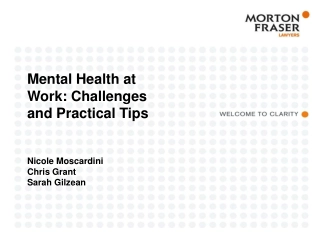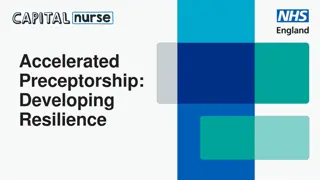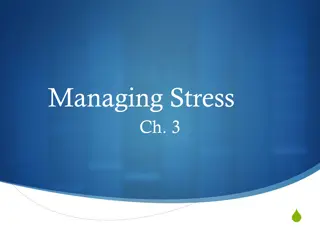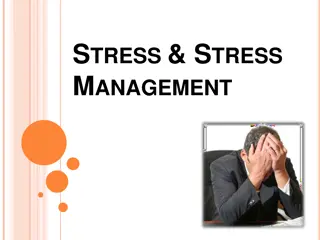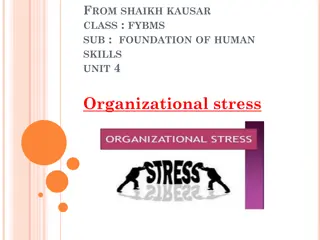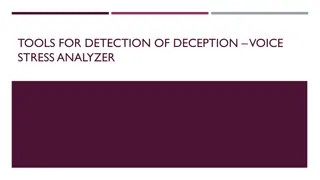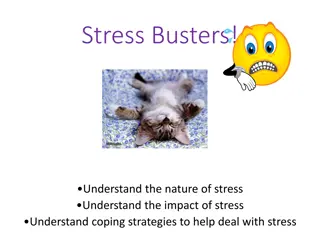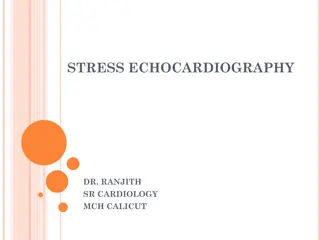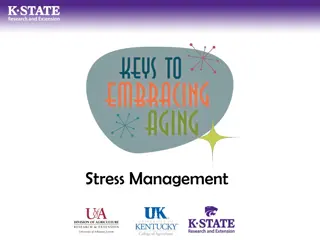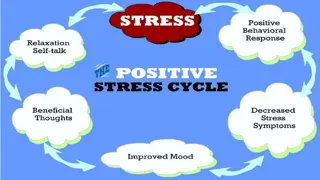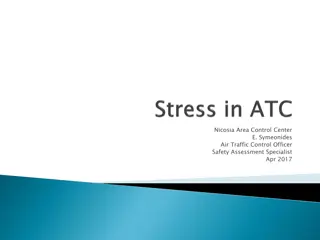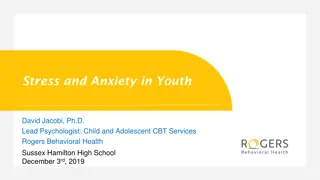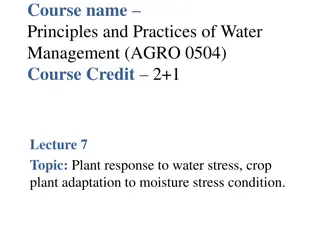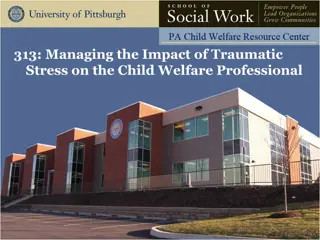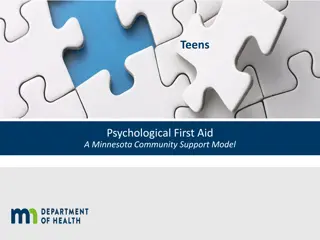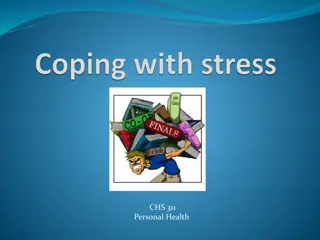Managing stress
Stress is a common experience, but managing it effectively is crucial for overall well-being. Learn practical tips and techniques to reduce stress, improve resilience, and enhance your mental health. Discover ways to create a healthier work-life balance, cultivate mindfulness, and build stress-coping skills that work for you. With the right tools and mindset, you can tackle daily challenges with confidence and maintain a sense of inner calm.
Download Presentation

Please find below an Image/Link to download the presentation.
The content on the website is provided AS IS for your information and personal use only. It may not be sold, licensed, or shared on other websites without obtaining consent from the author.If you encounter any issues during the download, it is possible that the publisher has removed the file from their server.
You are allowed to download the files provided on this website for personal or commercial use, subject to the condition that they are used lawfully. All files are the property of their respective owners.
The content on the website is provided AS IS for your information and personal use only. It may not be sold, licensed, or shared on other websites without obtaining consent from the author.
E N D
Presentation Transcript
5 Managing stress
How do I know if I am stressed? 2 Module 5
Stress The stress response The relaxation response Brings your system back into balance Deepens breathing Reduces stress hormones Slows heart rate Reduces blood pressure Relaxes muscles. Floods the body with chemicals to prepare for fight or flight Helpful in true emergency situations, to stay alert Wears the body down when constantly activated. 3 Module 5
Managing stress There are three kinds of stress: day-to-day stress critical incident stress (e.g., shooting, assault, fire) cumulative stress. If cumulative stress is not managed properly, service providers can experience burnout or vicarious trauma. This can be damaging for the individual, and also for their clients, if it is not recognized and managed. 4 Module 5
Stress 5 Module 5
What is burnout? Burnout is the result of chronic workplace stress that has not been managed successfully. It is characterized by: exhaustion or energy depletion feelings of negativity towards one's job reduced professional efficacy. Burnout is common among those who work with people in distress. 6 Module 5
Stress and burnout Stress Burnout Over-engagement Disengagement Emotions are over-reactive Emotions are blunted Urgency, hyperactivity Helplessness, hopelessness Loss of energy Loss of motivation, ideals and hope Leads to anxiety disorders Leads to detachment and depression Primary damage is physical Primary damage is emotional May kill you prematurely May make it seem that life is not worth living 7 Module 5
The consequences of burnout 8 Module 5
Caring for the carers Helping clients deal with physical abuse, sexual abuse, or HIV infection is emotionally draining. Issues that surface during counselling sessions may address painful or unresolved experiences of the counsellor. Counsellors often experience emotional burnout, depression, and difficulties in their own relationships. (Southern African AIDS Training Program, Counselling Guidelines on Domestic Violence, SAT, 2001, p. 21). 9 Module 5
Vicarious trauma Sometimes called secondary trauma or compassion fatigue Involves absorbing clients trauma Sufferers may re-experience difficult or traumatic events from their own past A process that unfolds over time it is not a response to one person, story or situation Is the cumulative effect of contact with survivors of violence, trauma and loss. 10 Module 5
Vicarious trauma: Impacts Persistently tense, upset or worried Job performance goes down, mistakes go up Morale drops Personal relationships are affected home life may start to deteriorate Can lead to overall decline in general health Changes in spirituality hopelessness, loss of faith. 11 Module 5
Recognizing signs of cumulative stress Each individual experiences stress differently. Have you observed any signs of cumulative stress in yourself or others? 12 Module 5
Know your warning signs Increased anxiety or edginess Easily angered by minor events, or feeling anger towards a lot of people and/or institutions Increased feelings of depression Hopelessness: feelings that no progress will ever be made Frustration with specific clients or GBV/SVAMB work in general Avoidance of social situations Increased fatigue Feelings of heightened responsibility for the well-being of clients. Feelings of insufficiency. Working more hours than those required of you 13 Module 5
Know your warning signs Feeling indifferent towards clients and the issue of GBV/SVAMB The absence of supervision and debriefing Inexplicable physical problems, such as tense muscles, persistent stomach aches or headaches, etc. Feelings of isolation: the sense that no one understands what you are experiencing Feeling guilty for being happy or for not having experienced GBV/SVAMB Nightmares about GBV/SVAMB Internalizing stories and being convinced that similar experiences will happen to you. Feeling overwhelmed by destructive or dangerous experiences (such as a suicidal client or staff assaults) 14 Module 5
Emotional response Emotional response What you can do Survivor LCM For survivor For yourself Establish safety procedures, talk with your organization about your fears. Of rejection or hurt. Of injury or being killed. Of what might happen to you. Of getting hurt. Listen, safety plan, alert supervisors. Fear Of severity or even the problem. It is a defence, continue to encourage to seek help. Find someone to talk to, process it. Of severity. Denial Establish realistic goals, check expectations, mobilize support networks, talk to supervisor. Lack of options and resources. Lack of options or resources for client. Help to find support network of others. Over-whelmed Can't do ANYTHING for survivor. Understand significance of even small steps. Know your resources, share concerns with others. Tired of no one caring. Discouraged 15 Module 5
Know your needs Each LCM should evaluate what they need in their lives in order to cope with their job. 16 Module 5
Brainstorm What are your signs that you are getting stressed and need a break? What do you know you need to have in your life in order to cope with stress? 17 Module 5
Stress management Stress reduction Module 5 18
Basic stress management To maintain well-being, the body needs regular, good quality: Exercise Nutrition Rest and sleep Relaxation Emotional, spiritual and intellectual self-care are also important 19 Module 5
What more can we do for ourselves? Escape! Rest! Play! Do things that you enjoy and that relax you. Talk to friends. Ask your friends to notice how you re doing. Debrief with staff/peers about particularly difficult cases, events or situations. Work to transform it vicarious transformation. 20 Module 5
Recap If cumulative stress is not managed properly, service providers can experience burnout or vicarious trauma. Each individual experiences stress differently, and it is important to recognize signs of cumulative stress. Basic stress management involves taking care of your body and mind. Paying attention to your physical health by eating right, getting enough sleep and exercising are also important. Escape, rest and play are three ways to manage stress and promote relaxation. 21 Module 5
Ways to manage stress at work: Supervision Module 5 22
Supervision Is the key strategy to ensure that staff are coping professionally and personally with their work. It is important for continued staff capacity development and to ensure quality of care. Can be provided through different approaches, including through one-on- one support, in groups, through on-the-job observation and coaching, and in regular team meetings. Can take multiple forms and can vary between countries. In the European context, we usually distinguish between: Internal supervision External supervision 23 Module 5
Internal supervision Occurs between the supervisor and supervisee within an organization where, commonly, the supervisor is also the manager or team leader and holds organizational accountabilities for the supervisee s practice. Commonly defined as 'line management'. Is the most traditional form of supervision. 24 Module 5
External supervision Takes place between a senior professional and a staff member who do not work for the same organization. Usually takes place outside of the staff member s place of work. Helps the staff member deal with work-related stress and conflict, workload management and work-life balance. Communication is key in effective external supervision. This means making sure that the people who provide the service get support with their own problems and feelings! 25 Module 5
External supervision is a process External supervision aims to: provide an opportunity to discuss practices to ensure quality service to clients provide a space to share experiences and to debrief ensure that staff do not become overwhelmed by their work emotionally monitor and manage stress give listeners the opportunity to be talkers. 26 Module 5
External supervision can include: individual discussions with a staff member: asking questions, listening, observing, advising, teaching, coaching, and mentoring facilitated debriefing sessions weekly or after particularly difficult or frustrating cases regular scheduled meetings that include informal discussions and continuing education specific and enforced policies and procedures that ensure staff security and set professional boundaries facilitated activities with staff that are simply fun and relaxing providing feedback for staff on their work performance, focusing in particular on their strengths and achievements. 27 Module 5
Peer supervision is an effective form of supervision provides staff with the opportunity to talk with each other about their work, to reflect on their work, and to share information, experiences and problems provides a space where service providers (and others) can listen to each other and give valuable feedback about their work-related challenges and effective strategies to overcome them should be a supportive learning and sharing experience. 28 Module 5
Peer supervision: For managers (and others) Pay attention to staff, peers, colleagues, partners notice how people are doing. Ensure clear roles and responsibilities of all staff including limitations. Enforce policies and procedures for professional boundaries and support staff in keeping within these boundaries. Make sure people use their time off. Consider virtual supervision for informal teams and peers through text messaging, chat groups or other forms of communication. 29 Module 5
Exercise Actions to take during the coming months 30 Module 5
Recap Supervision helps staff to cope professionally and personally with their work. There are different forms of supervision, including external and internal supervision, as well as peer supervision and virtual supervision. LCMs can ask for supervision sessions to debrief, they can form work teams to manage stress, and they can collaborate with peers who are not in their organizations to provide debriefing and stress management. 31 Module 5


